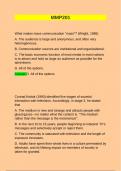MMP201
What makes mass communication "mass"? (Wright, 1986)
A. The audience is large and anonymous, and often very
heterogeneous.
B. Communication sources are institutional and organizational.
C. The basic economic function of most media in most nations
is to attract and hold as large an audience as possible for the
advertisers.
D. All of the options.
Answer:D. All of the options
Conrad Kottak (1990) identified five stages of societal
interaction with television. Accordingly, in stage 3, he stated
that
A. The medium is new and strange and attracts people with
glued gazes—no matter what the content is. "The medium
rather than the message is the mesmerizer".
B. In the next 10 to 15 years, people beginning to interpret TV's
messages and selectively accept or reject them.
C. The community is saturated with television and the length of
exposure increases.
D. Adults have spent their whole lives in a culture permeated by
television, and its lifelong impact on members of society is
taken for granted.
,Answer:C. The community is saturated with television and the
length of exposure increases.
What is the conditional effects model?
A. Most individuals in a mass society perceive messages from
media in the same fashion and react to them strongly and very
similarly.
B. The media can still have substantial effects, but only under
certain conditions or for certain audience members, often in
less dramatic form than suggested by the most vocal critics.
This is a model of selective effects based on individual
differences (Oliver & Krakowiak, 2009).
C. Media messages are thus "magic bullets" piercing the mind
of the populace.
D. The importance of repeated exposure to media stimuli and
suggests that effects are due not so much to a single exposure
as to the additive effects of many instances of exposure.
Answer:B. The media can still have substantial effects, but only
under certain conditions or for certain audience members, often
in less dramatic form than suggested by the most vocal critics.
This is a model of selective effects based on individual
differences (Oliver & Krakowiak, 2009).
In studies about the effects of e=xposure to mass
communication, general classes of measurable effects of media
include
,A. Demographic variables classifying the individual (e.g.,
gender, ethnicity, age), properties of the message (e.g., who
commits the violence and whether it is reinforced), or the
context of its reception (e.g., children watching television with
their parents or alone)
B. Direct, conditional, or cumulative effects models
C. Positive or negative aspects of media
D. Behavioral effects, attitudinal effects, cognitive effects,
physiological effects
Answer:D. Behavioral effects, attitudinal effects, cognitive
effects, physiological effects
Which following example can describe for physiological effects
of media?
A. A single exposure to a Seventeen supermodel is unlikely to
trigger an eating disorder, but repeated exposures to ultrathin,
large-breasted women may cumulatively encourage a young
woman to push her body in that direc- tion, especially if she
likes and identifies with the media models
B. Learning new information from media (e.g., facts about
chimpanzees from a National Geographic article)
C. Increasing in breathing and heart rate result from watching a
scary movie or an exciting ball game
D. Children randomly assigned to view high-risk behav- iors on
TV were more likely to later self-report their own tendency to
engage in risk-taking behaviors.
, Answer:C. Increasing in breathing and heart rate result from
watching a scary movie or an exciting ball game
Attitudes consist of two components (Festinger, 1957),
including:
A. An intellectual (belief) component (e.g., reasons that you
favor one political candidate's position over another's), and
emotional component (e.g., liking one candidate more than
another)
B. Positive feelings and negative feelings
C. Cognitive dissonance and cultivation
D. All options are correct
Answer:A. An intellectual (belief) component (e.g., reasons that
you favor one political candidate's position over another's), and
emotional component (e.g., liking one candidate more than
another)
As applied to media, a principle of the third-person effect
means
A. Different media may stimulate different types of cognitive
processing.
B. (1) people believe that other people are more vulnerable
than themselves to persuasive messages and other media
influences; and (2) such perceptions can influence behavior




